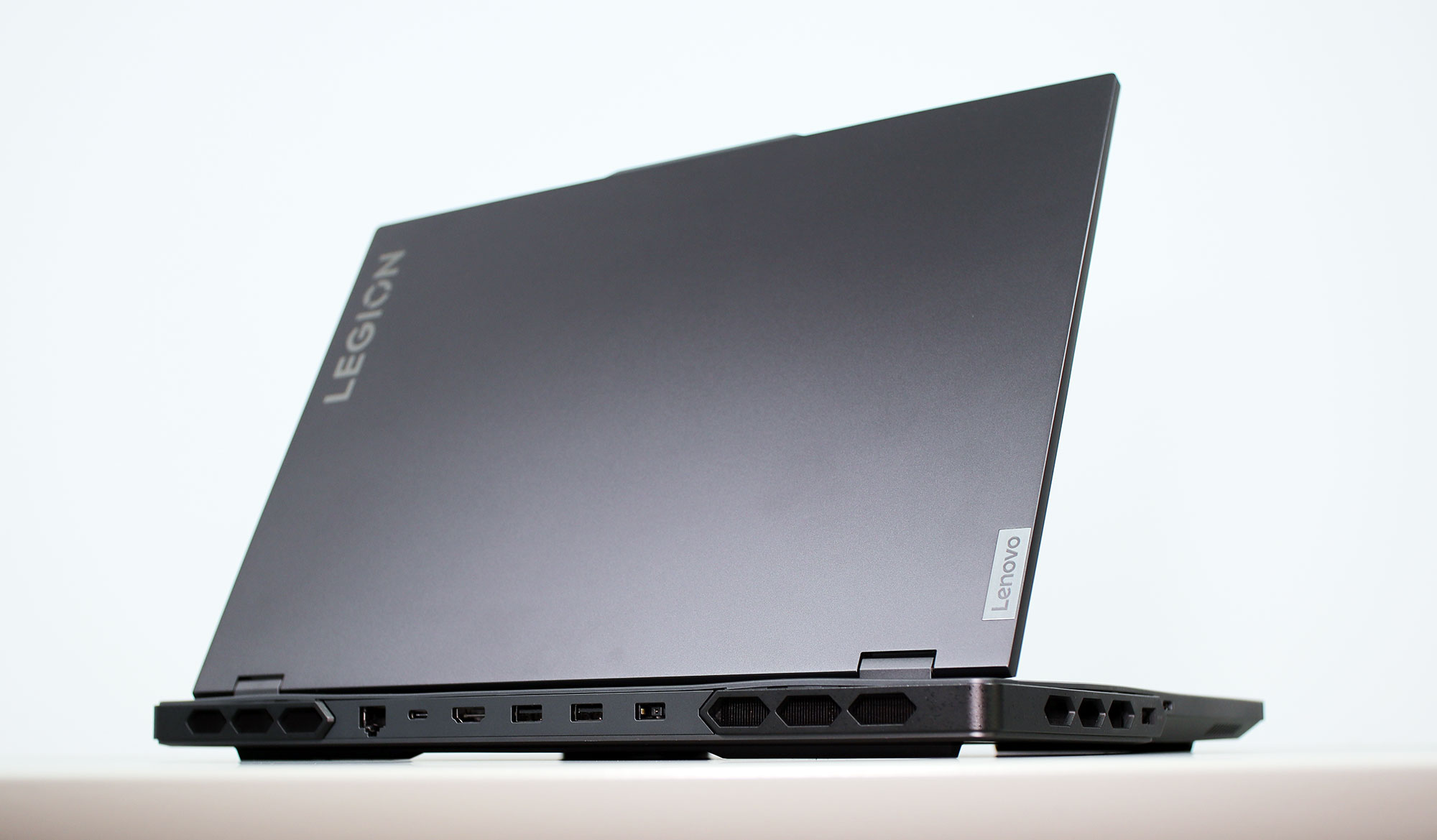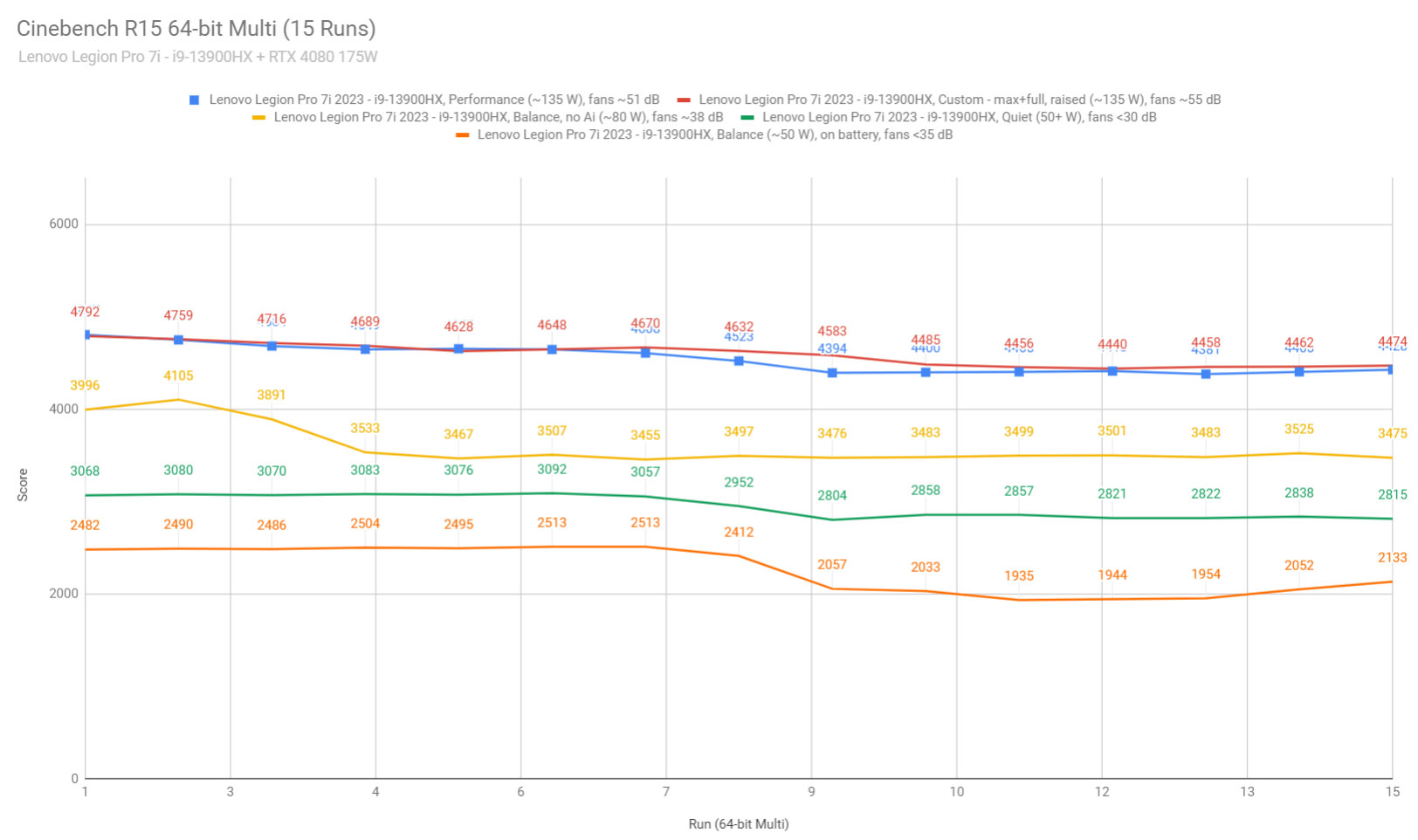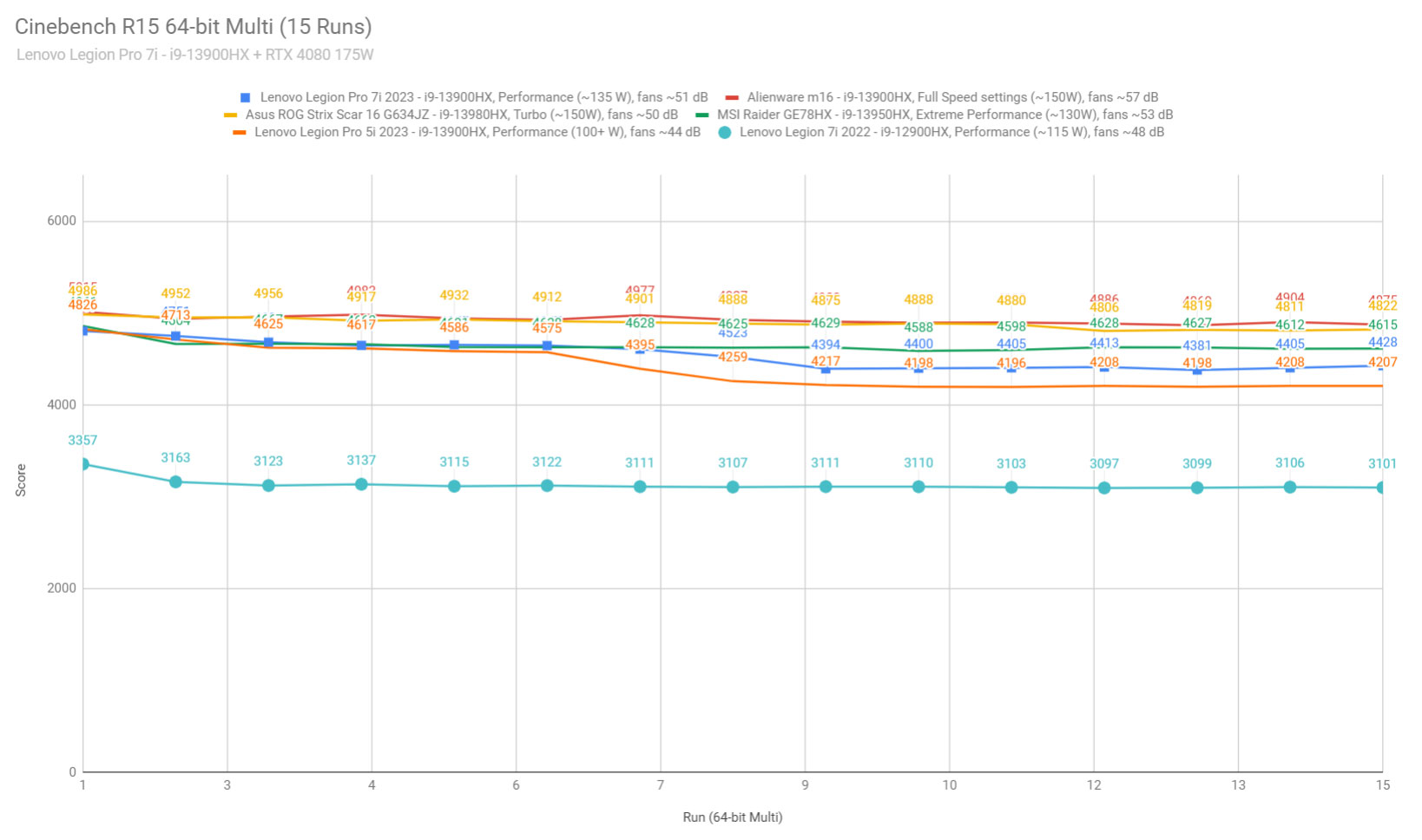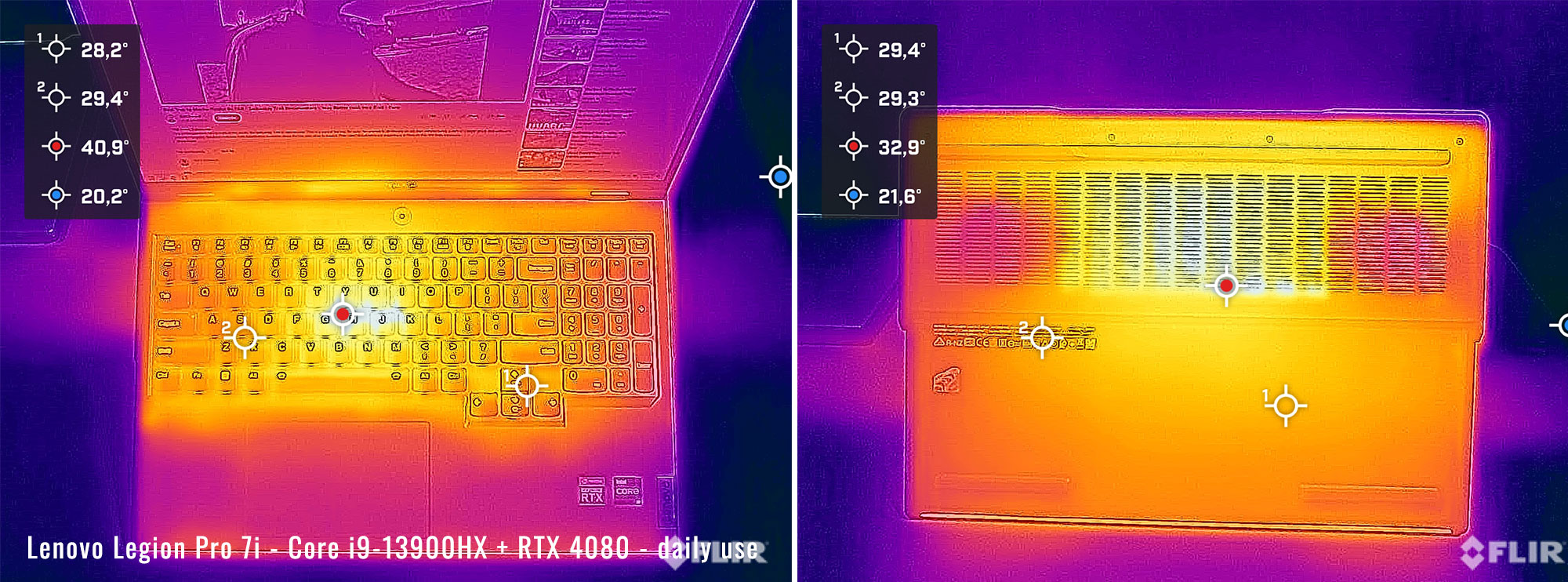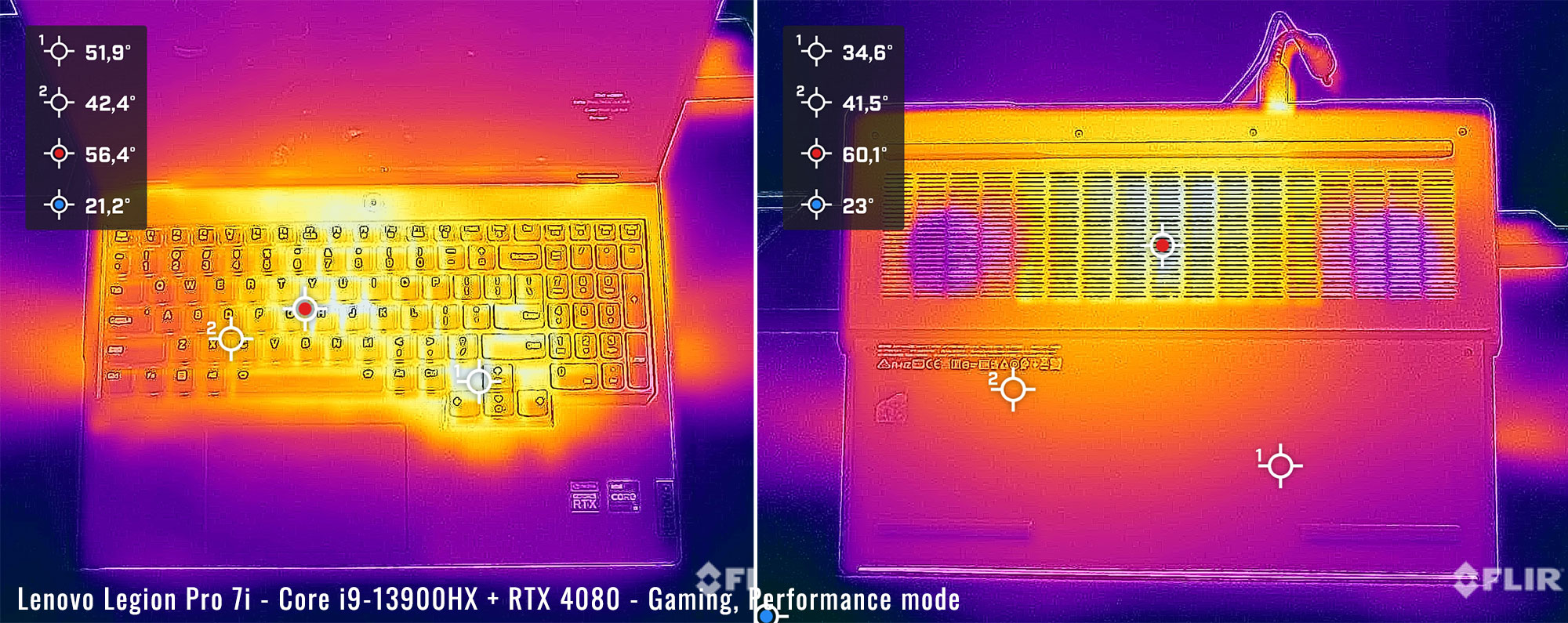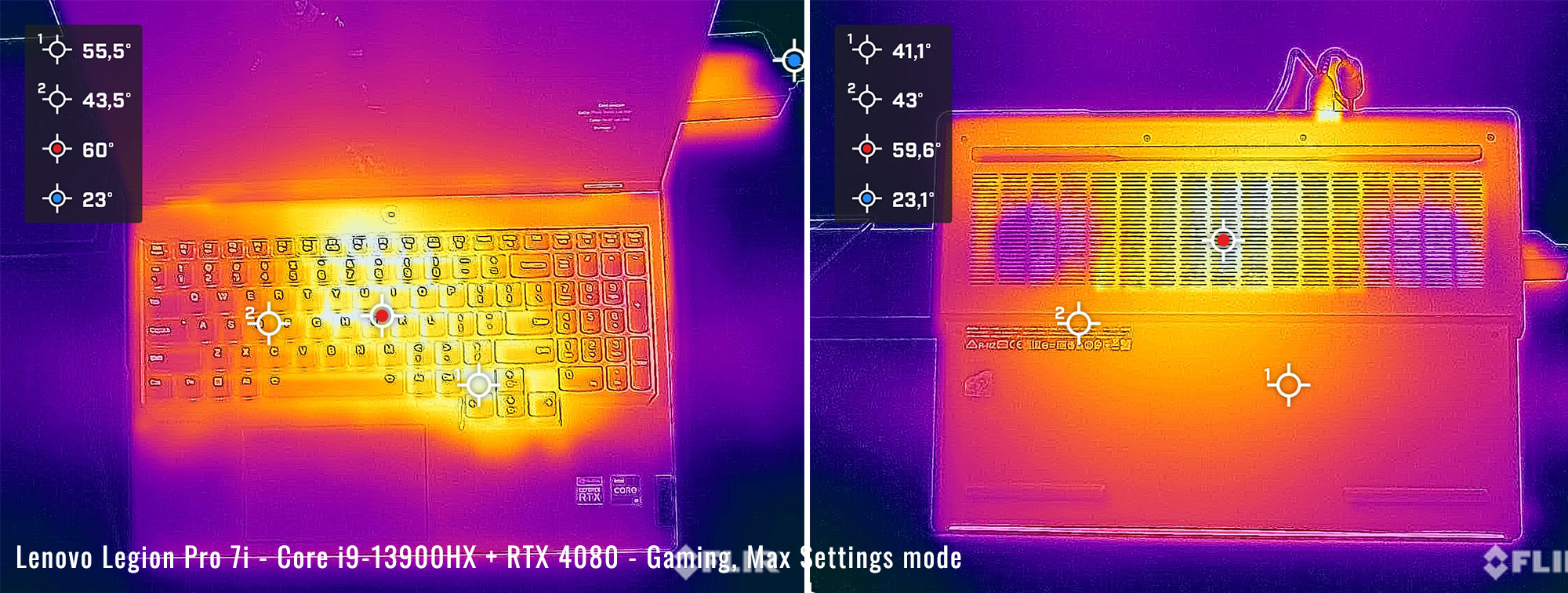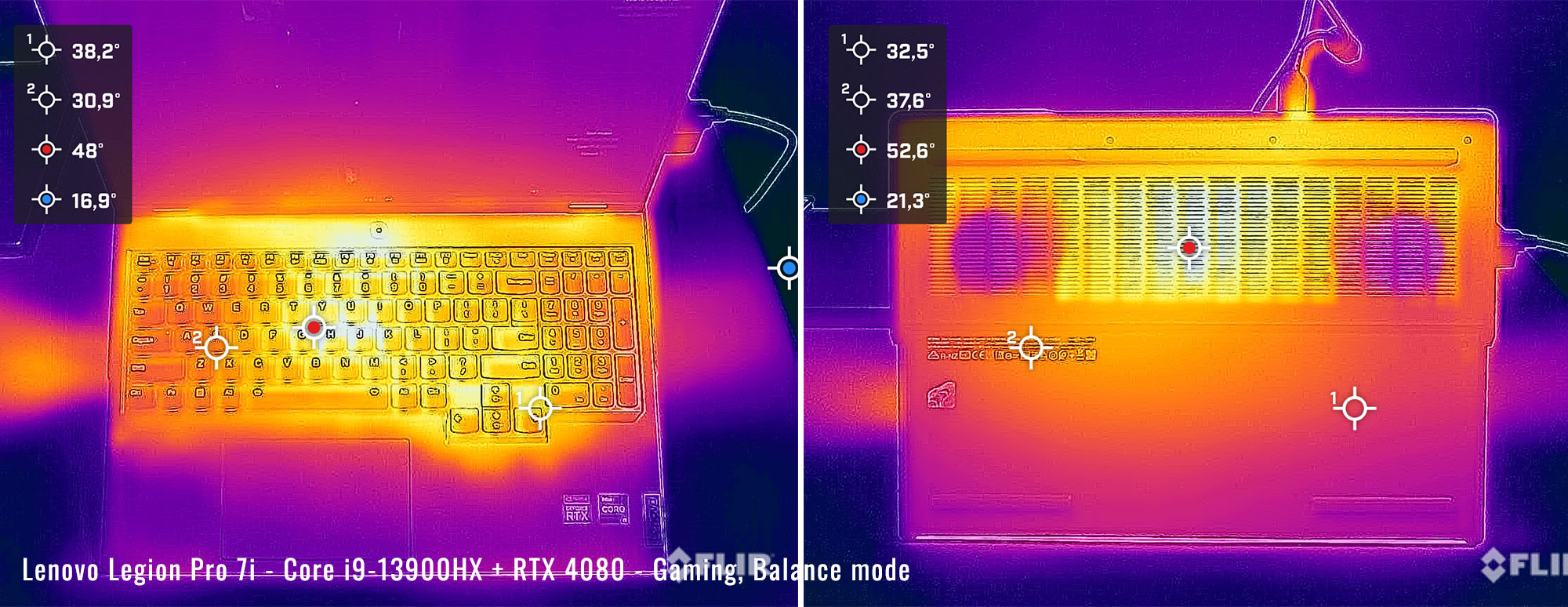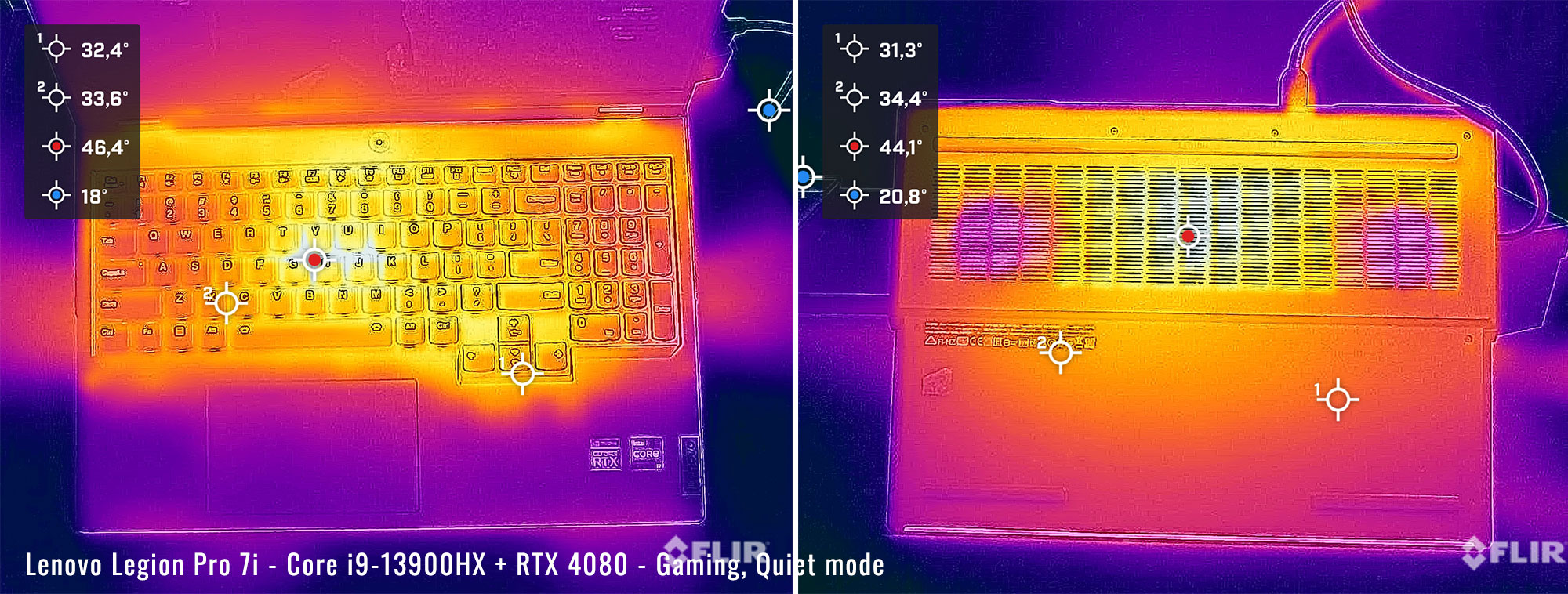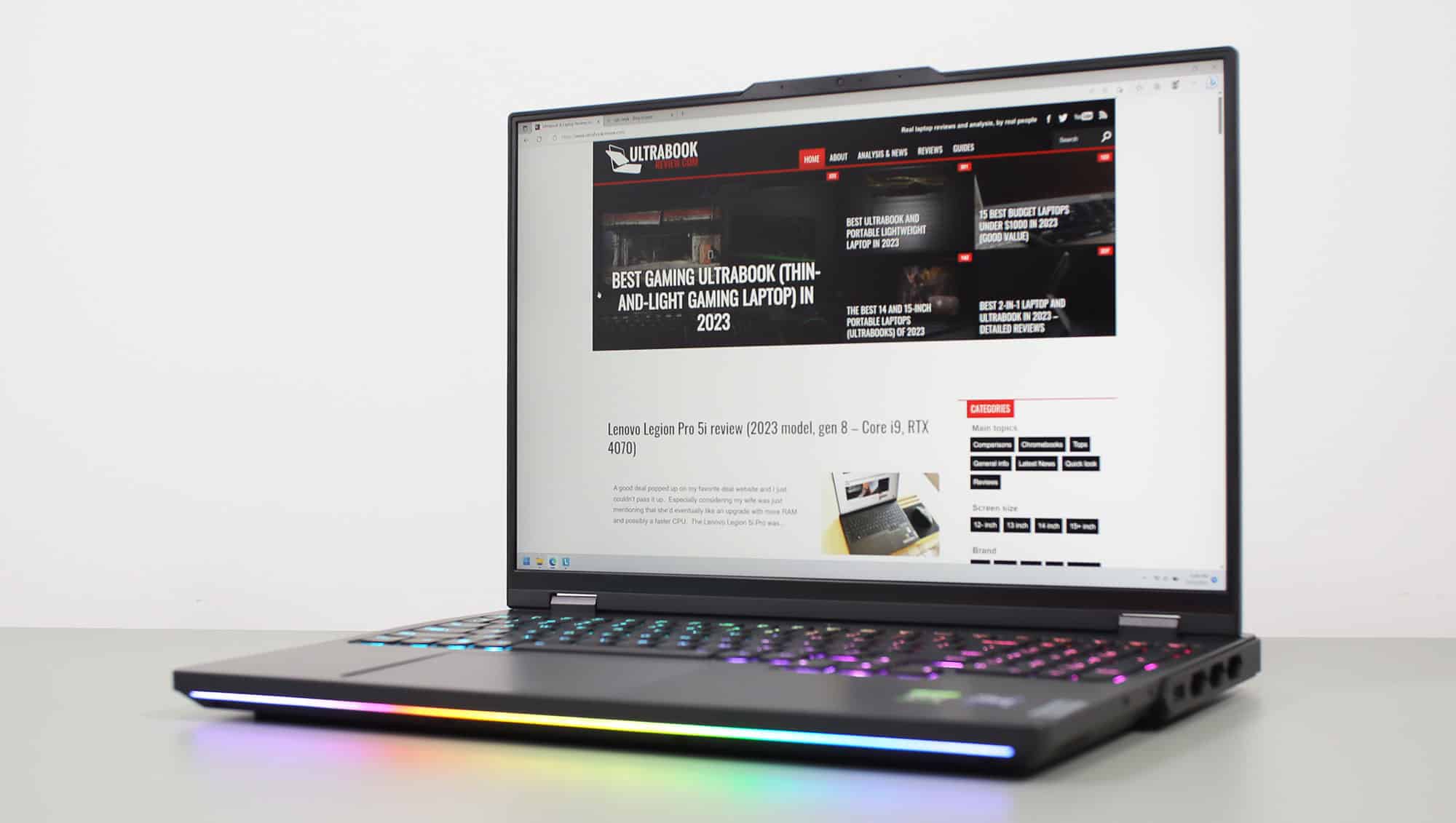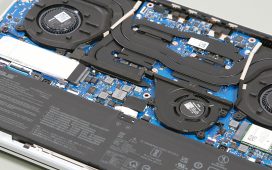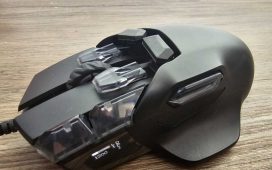This is our detailed review of the mid-2023 8th-generation update of the Lenovo Legion Pro 7 series, in the Legion Pro 7i variant built on 13th-gen Intel Core HX hardware and Nvidia RTX 4000 graphics.
The Pro 7i is the top-tier performance and gaming laptop in the Lenovo Legion family for the 2023 generation. I’ve used this laptop for the last few weeks and gathered my thoughts and impressions down below.
This 2023 Legion Pro 7i series updates the previous Legion 7 models in a few ways. It’s still a premium and fairly compact 16-inch chassis, but with a few changes in design and features, and more powerful hardware inside.
That makes this generation a little larger and heavier than before, as well as more powerful, both on the CPU and the GPU side. The battery is still 99.9 Wh, but Lenovo now bundles an updated GaN charger with this series, much lighter than the one used in the past. However, there’s still no wide-gamut screen option here, and the higher power hardware translates into toasty chassis temperatures in sustained loads. We’ll cover everything that you should know in the review.
Our review unit is arguably the better-value configuration available, with the Intel i9-13900HX processor and RTX 4080 graphics, but we’ll discuss the other options in this review as well. AMD-based Lenovo Legion Pro 7 models are also available, but we’ll cover those in future reviews.
Specs as reviewed– 2023 Lenovo Legion Pro 7i Gen 8
| Lenen Legion Pro 7 16IRX8H (Gen 8, 2023 model year) | |
| Screen | 16 inch, 16:10 format, 2560×1600 px, IPS, 240 Hz, matte, 3ms |
| Processor | Intel 13th-gen Raptor Lake HX, Core i9-13900HX, 8PC+16Ec/32T |
| Video | Iris Xe + NVIDIA GeForce RTX 4080 with 12GB GDDR6 VRAM 150-175W, with MUX, Advanced Optimus, and GSync |
| Memory | 32 GB DDR5-5600 (2x DIMMs), up to 64 GB |
| Storage | 1 TB PCIe gen4 (Samsung PM9A1) – 2x M.2 2280 PCIe gen4 SSD slots |
| Connectivity | WiFi 6E (Killer 1675i), Bluetooth 5.2, Gigabit Lan |
| Ports | Left: 1x USB-C 3.2 with Thunderbolt 4, 1x USB-A gen1 Right: 1x USB-A 3.2 gen1, 1x audio jack, 1x eShutter button Back: 2x USB-A gen1, 1x USB-C gen2 (DP, power), HDMI 2.1, LAN, DC-In |
| Battery | 99.9 Whr, 330 W GaN power adapter, USB-C charging up to 140W |
| Size | 363.4 mm or 14.33” (w) x 262.2 mm or 10.31 (d) x 21.95 – 25.9 mm or .86″ – 1.02” (h) |
| Weight | 2.65 kg (5.85 lbs) + .95 kg (2.1 lbs) for the charger+cables, EU version |
| Extras | per-key RGB backlit keyboard with NumPad, 1.5 mm travel, plastic clickpad, 2x 2W stereo speakers, FHD webcam with eShutter and Tobii Horizon, no figner-sensor in the power button anymore, available in a darker Space Grey color |
This series is available in a multitude of other specs, with either Intel Core i9 HX or AMD Ryzen 9 HX hardware and up to RTX 4090 graphics. We’ll cover other configurations in future reviews.
Design and construction
This 2023 Legion Pro 7i series is still an all-metal construction, much as the previous generations, but is a little larger in size and heavier. The differences are within mms and roughly 150 grams of weight, so nothing significant. More details on the design changes between the 2022 and 2023 Legion 7 generations are available in this previous article.
The new design particularities and the color scheme might not appeal to everyone, though. This is now a darker blue-gray finish, the kind that shows smudges and finger oil much easier than in the mid-grey metals used in the past.
That aside, the grills around the radiators have been redesigned and have this textured metal piece around that protrudes a little bit from the rest of the chassis. Not something I cared about, but a design aspect that was pointed out to me by at least two people during the time I used this laptop.
In fact, the whole design is a little more utilitarian this year, and perhaps not as flashy as the one of the previous generations, with those shiny metal edges and the RGB LEGION logo on the lid.
Nonetheless, this Legion Pro 7i 2023-model looks and feels much as you’d expect from a top-of-the-line Legion. The chassis is sturdy and well made, ergonomics are excellent, ports are lined on the back and on the sides, and the screen leans back flat to 180 degrees.
I do want to point out a few details here, though. For starters, the RGB has been simplified, with now only a subtle lightbar on the front lip. The keyboard is still full-RGB, though, but we’ll discuss that in a little bit.
The power button no longer integrates a finger-sensor with this generation, but still has an always-on light in it that lights up in White/Blue/Red based on the performance profile that you’re choosing. I don’t like having this light just under the screen, but at least it’s not that bright to be annoying when using the laptop at night.
For biometrics, Lenovo implemented an IR camera (Tobii Horizon) on this Pro 7i series, which resulted in a reversed notch at the top of the display. This design trick allows for slimmer bezels and also acts as a leaver to grab the screen from when opening up the laptop.
One other change is hidden behind the display, where the IO markup is no longer backlit on this generation, making it more difficult to find the right slot in a dim room.
You will, otherwise, find most of the needed ports on this series, both back there and on the sides. The LAN port is reversed now, though, and only support Gigabit speeds, and there’s still no SD card reader slot.
Keyboard and trackpad
The keyboard on the Pro 7i is similar in layout to the other Legion laptops, with a main deck of full-sized and properly-spaced keys, plus a smaller NumPad section at the right. The main set of keys is shifted to the left side, as a result, in comparison to a centered layout without NumPad. The directional keys are full-size and well-spaced out from everything around.
The keycaps are made from a soft-feeling plastic and have a small ditch in them. The stroke depth is 1.5 mm, a bit shorter than on other gaming laptops, but the feedback is still OK. However, for some reason, I didn’t get the same typing performance on this generation as on the previous Legion 7 keyboards. Somehow, this keyboard felt mushier to me, but without having the two generations side by side, I can’t pinpoint what has changed on this 2023 model.
The lighting is RGB on this keyboard and one of the better in the laptop space. Bright and uniform LEDs are placed under each keycap, and very little light shines out from underneath the keys. Per-key RGB control is possible in the Spectrum app, which is part of the Lenovo Vantage main control software.
Lenovo also implements here that neat functionality that lights up only the active keys when pressing Fn. This way, it’s easier to find the required shortcut, and there are quite a few of them for different things.
Other details worth mentioning are the fact that you get useful physical indicators for CapsLock, FnLock, and NumLock on this layout. However, there’s still no way to set up a timeout period for the keyboard’s lighting, which means you’ll have to manually enable/disable the lights when needed. Not a deal-breaker, but an oddity for Lenovo laptops.
The clickpad on this laptop is an averagely-sized surface that seems to be made out of plastic, and not glass as in the past. In fact, Lenovo might have decided on offering the exact same implementation on both their Legion Pro 7 and Pro 5 models this year.
Regardless, it worked fine during my time with the laptop, and I haven’t noticed anything unusual such as rattling with firmer taps or issues with palm rejection.
Finally, for biometrics, there’s no longer a finger sensor in the power button here, but an IR capable camera with Tobii Horizon support is offered instead, implemented at the top of the display.
Screen
There’s a 16-inch 16:10 display in the 2023 Legion Pro 7 series, just like in the past Legion 7 generations.
The panel on our unit is 2560 x 1600 px QHD+ resolution, 500+ nits of brightness, and 100% sRGB color coverage, with variable refresh rates between 165-240Hz, fast response times, and GSync.
This is fine for daily use and well-suited for gaming. Despite only covering the sRGB gamut, the content and colors look good, especially when you pump up the brightness.
However, this panel is no longer on par with what the competition offer on their similar-tier notebooks, especially with the mini LED variants. Given that this series is Lenovo’s highest-tier Legion, I would have also hoped for a mini LED panel option.
Here’s what we got in our tests, with an X-Rite i1 Display Pro sensor:
- Panel HardwareID: CSOT T3 MGN0007DA2-3;
- Coverage: 99.4% sRGB, 71.6% DCI-P3, 74.2% AdobeRGB;
- Measured gamma: 2.09;
- Max brightness in the middle of the screen: 539.11 cd/m2 on power;
- Min brightness in the middle of the screen: 5.52 cd/m2 on power;
- Contrast at max brightness: 1236:1;
- White point: 6500 K;
- Black on max brightness: 0.19 cd/m2;
- PWM: No.
Calibration is fine out of the box, with only a slight skewing in Gamma. The panel is also uniformly lit, without any luminosity or DeltaE imbalances or noticeable light-bleeding, even at maximum brightness levels.
Hardware and performance
Our test model is a higher-specced configuration of the 2023 Lenovo Legion Pro 7i, built on an Intel Core i9-13900HX processor, 32 GB of DDR5-5600 memory, 1 TB of fast SSD storage, and dual graphics: the Nvidia RTX 4080 dGPU and the Intel iGPU integrated within the Intel processor.
Disclaimer: This is a retail unit provided for this review by Lenovo, and it runs on the software available as of mid-May 2023 (BIOS KWCN26W, Vantage 3.13.43.0, GeForce 531.79 drivers). Some aspects might change with later updates.
Spec-wise, the 2023 Legion Pro 7i is built on the latest and most powerful Intel and Nvidia hardware available to date. The Core i9-13900HX is a high-performance mobile processor in Intel’s Raptor Lake 13th-gen platform, with 24 Cores and 32 Threads. It is a hybrid design with 8 High-Performance and dual-threaded Cores, and 16 extra Efficiency cores, which work together in the various loads. The design and thermal module of this Legion allow the processor to run at ~135W of sustained power in demanding CPU loads.
For the GPU, the 2023 Legion Pro 7i series is available with full-power RTX 4000 graphics chips. On this sample is the Nvidia GeForce RTX 4080 12GB running at up to 175W with Dynamic Boost. RTX 4090 16GB and RTX 4070 150W configurations are available as well.
A MUX is offered here, with Advanced Optimus. Vantage also allows for a couple of power modes. Hybrid enables Advanced Optimus and should cover most needs as long as the laptop is plugged in. A dGPU-only mode is also available, and this requires a restart to enable.
For the RAM, the series offers two DDR5 DIMMs. Our unit is a 32 GB of DDR5-5600 RAM (2x 16 GB) configuration.
For storage, there are two M.2 2280 PCIe gen4 slots on this series, and our sample comes preconfigured with a fast gen4 Samsung PM9A1 drive.
Getting to the components requires you to remove a few Philips screws, all visible around the back, and then pull up the D-panel. You’ll need a plastic pin and some sort of suction cup to pull out the bottom panel, as it is fairly snugly attached to the main chassis. Inside, everything is encapsulated, the RAM is covered by a metal shield, and the SSDs and wifi slots are also covered by thermal radiators. You’ll need to remove those in order to access the components.
For the software, this unit came with Windows 11 preinstalled and the standard set of Lenovo apps – you might want to uninstall some of them. I like the predefined wallpaper, it looks so much nicer than what most OEMs offer these days.
The power profiles are Quiet, Balance, Balance with Legion Ai, and Performance, and you can select them from Vantage or switch between them with Fn+Q. There’s also an advanced Custom mode that allows granular tweaking of various settings and power limits.
These profiles apply different power settings to the CPU/GPU and different fan profiles, as well as switch the color of the LED in the power button. Here’s a table that shows what each mode does:
| Quiet (blue) | Balance (white) | Balance + Ai(white) | Performance (red) | ||||
| TDP PL1/PL2 | TGP | TDP PL1/PL2 | TGP | TDP PL1/PL2 | TGP | TDP PL1/PL2 | TGP |
| 25/65W | ~35W | 80W/120W | ~100W | – | up to 175W | 135W/190W | up to 175W |
This series also offers a quick dGPU Overclocking toggle, which applies +100 MHz Core, +200 MHz Memory settings. We’ve used these settings for all our tests, but further tweaking is also possible if you want to.
Before we jump to the performance section, here’s how this laptop handles everyday use and multitasking on the Quiet/Balance profiles, unplugged from the wall.
Performance and benchmarks
On to more demanding loads, we start by testing the CPU’s performance by running the Cinebench R15 test for 15+ times in a loop, with a 1-2 seconds delay between each run.
With the laptop sitting on the desk and on Performance mode, the Core i9-13900HX processor kicks in aggressively at ~190 W and then stabilizes at ~135W of sustained power. The CPU is power-limited in this sort of load, as the temperatures stabilize at around 85 C, so would allow for higher sustained power. This is a massive improvement from the previous Legion 7 generation.
Maxing out the setting in the Custom mode and raising the laptop on a stand in order to favor airflow into the bottom-placed fans doesn’t impact the performance or general behavior in any notable way. The fans run louder in this mode, though.
Switching over to the Balance profile translates into the CPU running at ~80W sustained, with Legion Ai switched Off. The fans run significantly quieter in this mode and internal temperatures are still around mid to high 80s C, but the performance takes a 30% dip with this sort of power limit.
The Quiet profile keeps the fans at sub 30 dBA, with a harsher power limit and about 60% of the performance offered with the top profiles. Not bad.
Finally, the CPU runs at 35-50 W on battery, on the Balance profile. Details below.
Overall, these profiles are much better polished than the ones tested in the 2023 Legion 7i review unit. The laptop is no longer thermally limited in any situation, and there’s a good variation of noise/power between settings.
To put these findings in perspective, here’s how this Core i9-13900HX implementation fares against other performance laptops in this test.
The Legion Pro 7i is a balanced performer in this test, within 10% of the fastest Core HX implementations that are running at higher sustained power and a little faster than the Legion Pro 5i. At the same time, this is a massive step up in performance over the previous 2023 Legion 7i (i7-12900HX variant).
We then went ahead and further verified our findings with the more taxing Cinebench R23 loop test and Blender – Classroom, which resulted in similar findings to what we explained above.
We also ran the 3DMark CPU test on the Performance profile.
Finally, we ran our combined CPU+GPU stress tests on this notebook. 3DMark stress runs the same test for 20 times in a loop and looks for performance variation and degradation over time, and this unit passed it just fine, which means there’s no performance throttling with longer-duration sustained loads.
Next, we ran the entire suite of tests and benchmarks, on the Performace profile with the GPU set on the Hybrid mode (MUX on Advanced Optimus), and with the screen set at the native QHD+ resolution.
Here’s what we got:
- 3DMark 13 – CPU profile: max – 11724, 16 – 9669, 8 – 7792, 4 – 4317, 2 – 2170, 1 – 1082;
- 3DMark 13 – Fire Strike (DX11): 31551 (Graphics – 40636, Physics – 37173, Combined – 10867);
- 3DMark 13 – Port Royal (RTX): 7021;
- 3DMark 13 – Time Spy (DX12): 18781 (Graphics – 19578, CPU – 15262);
- 3DMark 13 – Speed Way (DX12 Ultimate): 4828;
- Uniengine Superposition – 1080p Extreme: 10718;
- Uniengine Superposition – 1080p Medium: 30284;
- Handbrake 1.3.3 (4K to 1080p encode): 74.89 average fps;
- Handbrake 1.6.1 (4K to 1080p encode): 110.85 average fps;
- PassMark 10: Rating: 6235 (CPU: 51309, 3D Graphics: 30342, Memory: 3338, Disk Mark: 30480);
- PCMark 10: 8358 (Essentials – 12191, Productivity – 11572, Digital Content Creation – 11234);
- GeekBench 5.5.1 64-bit: Multi-core: 20729, Single-Core: 2066;
- GeekBench 6.0.2: Multi-core: 17078, Single-Core: 2723;
- CineBench R15 (best run): CPU 4807 cb, CPU Single Core 301 cb;
- CineBench R20 (best run): CPU 11659 cb, CPU Single Core 778 cb;
- CineBench R23: CPU 30747 cb (best single run), CPU 27871 cb (10 min run), CPU Single Core 2045 cb;
- x265 HD Benchmark 64-bit: 20.12 s.
And here are some workstation benchmarks, on the same Turbo profile:
- Blender 3.01 – BMW scene – CPU Compute: 1m 25s ;
- Blender 3.01 – BMW scene – GPU Compute: 11.74s (CUDA), 7.04s (Optix);
- Blender 3.01 – Classroom scene – CPU Compute: 3m 31s;
- Blender 3.01 – Classroom scene – GPU Compute: 24.06s (CUDA), 15.32s (Optix);
- Blender 3.41 – BMW scene – CPU Compute: 1m 23s;
- Blender 3.41 – BMW scene – GPU Compute: 11.60s (CUDA), 6.41 (Optix);
- Blender 3.41 – Classroom scene – CPU Compute: 3m 33s;
- Blender 3.41 – Classroom scene – GPU Compute: 21.51s (CUDA), 13.06s (Optix);
- PugetBench – DaVinci Resolve: 1850 points;
- PugetBench – Adobe After Effects: 1222;
- PugetBench – Adobe Photoshop: 1172;
- PugetBench – Adobe Premiere: 1343;
- SPECviewperf 2020 – 3DSMax: 180.38;
- SPECviewperf 2020 – Catia: 104.06;
- SPECviewperf 2020 – Creo: 134.34;
- SPECviewperf 2020 – Energy: 63.58;
- SPECviewperf 2020 – Maya: 563.95;
- SPECviewperf 2020 – Medical: 57.13;
- SPECviewperf 2020 – SNX: 31.60;
- SPECviewperf 2020 – SW: 427.57.
- V-Ray Benchmark: 19797 – CPU, 2092 – CUDA, 2816 – RTX.
This is a good high-tier performer and will cope well with daily multitasking, workloads, and games.
It’s mostly on par in mixed-loads with other i9 + RTX 4080 units we’ve reviewed, although some units do score a little higher in full-CPU loads, due to their ability to run the i9 at higher sustained power. You’ll also get higher CPU performance with the AMD-based Ryzen HX units out there, including the AMD variant of the Legion 7.
Compared to the i9 + RTX 4070 configuration of the Legion Pro 5i, this is a major step-up in graphics performance, and a slit step-up in CPU performance.
Furthermore, this Legion Pro 7i generation is significantly faster in all tests than the i9-12900HX + RTX 3080Ti configuration of the 2022 Legion 7i tested in the past.
Performance Mode vs. Balance, Quiet
Let’s also touch on the Balance and Quiet profiles offered in Vantage.
The laptop runs at ~51 dBA on the Performance profile, which is fair for a high-performance device, but still loud. So if you’re willing to sacrifice the performance to some extent to keep the fans even quieter, the Balance and Quiet profiles should be of interest.
Here’s how this 2023 Legion Pro 7i performs on the Balance profile, which limits the fans to around 42 dB at head level.
- 3DMark 13 – Fire Strike: 28215 (Graphics – 36577, Physics – 35138, Combined – 9374);
- 3DMark 13 – Time Spy: 14304 (Graphics – 14331, CPU – 14157);
- Uniengine Superposition – 1080p Extreme: 9551;
- CineBench R20 (best run): CPU 10400 cb, CPU Single Core 774 CB;
- Blender 3.41 – Classroom scene – CPU Compute: 4m 16s.
The CPU runs at about 80-90% of its Performance capabilities in sustained loads. The difference is greater in longer sustained load, where the power cap kick in.
The GPU, on the other hand, runs at about 85% of its Turbo mode performance as well.
You can also opt for the Quiet profile, in which case the fans won’t go over 35 dB. Here’s what we got in this case:
- 3DMark 13 – Fire Strike: 9485 (Graphics – 9200, Physics – 12589, Combined – 8343);
- 3DMark 13 – Time Spy: 7021 (Graphics – 6556, CPU – 11742);
- Uniengine Superposition – 1080p Extreme: 5361;
- CineBench R20 (best run): CPU 7491 cb, CPU Single Core 780 CB;
- Blender 3.41 – Classroom scene – CPU Compute: 7m 12s.
Both the CPU and the GPU are aggressively limited in this mode, due to the power limitations applied by the profile. They run at roughly 50% of their abilities in Performance mode. Given the differences in noise levels between Quiet and Balance, this Quiet mode is not a feasible option for demanding loads, but is recommended for light daily use.
Gaming performance
Let’s see how this Lenovo Legion Pro 7i handles modern games.
We tested a couple of different types of games on the various available profiles at QHD+ and FHD+ resolution, all with the MUX manually set on the dGPU mode and the GPU on the Overclocked mode.
Here are the results:
| Core i9-13900HX + RTX 4080 Laptop 150-175W |
QHD+ Performance, dGPU, on desk |
QHD+ Balance, dGPU, on desk |
FHD+ Performance, dGPU, on desk |
FHD+ Quiet, dGPU, on desk |
| Cyberpunk 2077 (DX 12, Ultra Preset, RTX OFF) |
55 fps (45 fps – 1% low) | 46 fps (38 fps – 1% low) | 119 fps (46 fps – 1% low) | 52 fps (28 fps – 1% low) |
| Doom Eternal (Vulkan, Ultra Preset) |
334 fps (82 fps – 1% low) | 238 fps (46 fps – 1% low) | 452 fps (56 fps – 1% low) | 196 fps (38 fps – 1% low) |
| Far Cry 6 (DX 12, Ultra Preset, TAA) |
120 fps (82 fps – 1% low) | 98 fps (78 fps – 1% low) | 122 fps (89 fps – 1% low) | 56 fps (37 fps – 1% low) |
| Far Cry 5 (DX 11, Ultra Preset, SMAA) |
157 fps (98 fps – 1% low) | 123 fps (78 fps – 1% low) | 176 fps (121 fps – 1% low) | 89 fps (66 fps – 1% low) |
| Metro Exodus (DX 12, Ultra Preset, RTX OFF) |
102 fps (72 fps – 1% low) | – | 172 fps (92 fps – 1% low) | – |
| Red Dead Redemption 2 (DX 12, Ultra Optimized, TAA) |
121 fps (38 fps – 1% low) | 98 fps (34 fps – 1% low) | 139 fps (49 fps – 1% low) | 64 fps (46 fps – 1% low) |
| Resident Evil 4 (DX 12, Prioritize Graphics, TAA) |
134 fps (108 fps – 1% low) | 112 fps (78 fps – 1% low) | 198 fps (152 fps – 1% low) | 112 fps (68 fps – 1% low) |
| Shadow of Tomb Raider (DX 12, Highest Preset, TAA) |
147 fps (59 fps – 1% low) | 125 fps (55 fps – 1% low) | 165 fps (82 fps – 1% low) | 63 fps (36 fps – 1% low) |
| The Witcher 3: Wild Hunt (v4.01) (DX 12, Ultra Preset, TAAU) |
131 fps (36 fps – 1% low) | 114 fps (33 fps – 1% low) | 137 fps (39 fps – 1% low) | 92 fps (38 fps – 1% low) |
- Battlefield V, Cyberpunk, Doom, Witcher 3 – recorded with Fraps/in-game FPS counter in campaign mode;
- Far Cry 5, 6, Metro, Red Dead Redemption 2, Tomb Raider – recorded with the included Benchmark utilities;
- Red Dead Redemption 2 Optimized profile based on these settings.
Those above are rasterization tests, and here are some results for RTX – Ray Tracing performance, with and without DLSS.
| Core i9-13900HX + RTX 4080 Laptop 150-175W | QHD+ Performance, dGPU | FHD+ Performance, dGPU |
| Cyberpunk 2077 (DX 12, Ultra Preset + RTX, DLSS3 Off) |
35 fps (21 fps – 1% low) | 62 fps (38 fps – 1% low) |
| Cyberpunk 2077 (DX 12, Ultra Preset + RTX, DLSS3 Balanced) |
110 fps (42 fps – 1% low) | 157 fps (64 fps – 1% low) |
| Doom Eternal (DX 12, Ultra Preset, RTX On, DLSS2 Off) |
226 fps (36 fps – 1% low) | 326 fps (62 fps – 1% low) |
| Doom Eternal (DX 12, Ultra Preset, RTX On, DLSS2 Quality) |
273 fps (46 fps – 1% low) | 366 fps (68 fps – 1% low) |
| Far Cry 6 (DX 12, Ultra Preset + DXR reflections / shadows) |
106 fps (78 fps – 1% low) | 102 fps (80 fps – 1% low) |
| Shadow of Tomb Raider (DX 12, Highest Preset, TAA, RTX Ultra, DLSS2 Off) |
99 fps (67 fps – 1% low) | 124 fps (84 fps – 1% low) |
| Shadow of Tomb Raider (DX 12, Highest Preset, TAA, RTX Ultra, DLSS2 On) |
115 fps (64 fps – 1% low) | 128 fps (71 fps – 1% low) |
| The Witcher 3: Wild Hunt (v4.02 update) (DX 12, Ultra Preset, RT Ultra, DLSS3 Off – TAAU) |
73 fps (18 fps – 1% low) | 85 fps (19 fps – 1% low) |
| The Witcher 3: Wild Hunt (v4.02 update) (DX 12, Ultra Preset, RT Ultra, DLSS3 On) |
128 fps (32 fps – 1% low) | 154 fps (34 fps – 1% low) |
This configuration runs well in all these modern games at QHD+ resolution and Ultra settings. RT performance is also impressive for the 4080 configuration, especially with DLLS3 in supported titles.
With that out of the way, let’s go over some performance and temperature logs.
The Performance mode ramps up the fans to levels of ~50-51 dB with the laptop sitting on the desk. That keeps the CPU at around 80-85 degrees Celsius between the tested titles, while the GPU runs at between 78-82 degrees. Fair temperatures for this sort of components.
Raising the back of the laptop from the desk in order to improve the airflow into the fans leads to a slight decrease in CPU/GPU temperatures, of 2-4 degrees. Both components end up running at around 75-82 C in most titles. That means I would recommend opting for a passive raiser-stand or even an active cooling pad for long gaming sessions, although that’s not a must, as on-desk behavior is still perfectly fine here.
Keep in mind that the fans are perceived a little louder with the back of the laptop bumped off the desk, at around 52 dB.
Opting for the Custom mode and ramping up the fans to 100% translates into noise levels of 55+ dBA at head level.
The GPU works similarly as on Performance mode and ends up running a little cooler with these settings, but the CPU receives more power on Custom and thus runs at higher temperatures, averaging 85-90 degrees Celsius.
For the most part, this Custom profile is superfluous here, but it might make sense in CPU-heavy titles, where the extra CPU power could prevent bottlenecks and frame drops.
Then there’s the Balance mode. With the AI Engine disabled, the fans stabilize at around 42 dBA, much quieter than on the previous profiles.
The framerates take a hit, averaging about 75-80% of what the laptop does on Performance, but most titles are still perfectly playable on this mode as well. Plus, the internal temperatures are excellent, within high 60s to mid 70s on both components, even with the laptop flat on the desk.
With Legion Ai enabled on Balance, the laptop performs more-or-less as in Performance mode. Hence, I don’t see the point of this setting for longer gaming sessions, when you can opt for Performance mode instead when needed.
As for the Quiet mode, it keeps the fans at sub 35 dB levels and caps the power on the CPU and especially the GPU aggressively, but is still usable at FHD+ resolution with High/Ultra settings.
As for the laptop’s performance on battery power, I forgot to log it for this review, but is somewhat similar to the Quiet mode explained above. Hence, FHD+ with High settings should be doable in most games. Don’t expect more than 1 to 2 hours of gameplay, based on how much are you willing to limit the framerates’ cap.
Noise, Heat, Connectivity, speakers, and others
This Legion Pro 7i gets Lenovo’s most advanced thermal module design, with a large vapor chamber, two high-capacity fans, and four radiators (two on the back and two on the sides). Radiator shields are also mounted over the RAM modules, SSDs, and even the wifi card.
This seems similar to the cooling on the previous Legion 7 models, but the overall cooling in sustained loads is improved between generations, as shown in the previous section.
The fans are no longer as aggressively choked up by the slim feet design with the laptop sitting on a flat surface, but I’d still recommend using at least a passive raiser stand for sustained loads on the Performance mode, in order to keep the external chassis temperatures at bay as much as possible. More on that in a bit.
On the other hand, Balance mode is perfectly usable even with the laptop on the desk, with quieter fans, but also with a notable toll in framerates and capabilities.
As far as the fan noise goes, we’re looking at ~50-52 dB at head-level on the Performance mode, 42 dB on Balance mode (without Legion Ai Engine), and sub 35 dB on Quiet mode, all with demanding activities.
With lighter use, you’ll hardly hear the fans on Balance or Quiet – they never idle, but keep almost silent at levels that are barely noticeable even in a perfectly quiet room. I also haven’t noticed any coil whining or electronic noises on this unit.
As far as temperatures go, no major complaints with daily use. The hottest spot reaches temperatures in the low-30s, but is somewhat inconveniently positioned in the middle of the keyboard. The back rarely goes over low-30s.
*Daily Use – streaming Netflix in EDGE for 30 minutes, Quiet profile, fans sub 30 dB
With games and with the laptop on a flat surface, hotspots develop in the middle of the keyboard, around the power button, and around the arrows keys, and they go over 50 degrees Celsius. That’s high and as a result, this laptop can feel uncomfortable to the touch, especially in the area around the directional keys. The back also pushes to 60s C over the components.
Furthermore, these chassis temperatures are higher than on the previous Legion 7 series, by as much as 10 degrees Celsius around the hotspots.
*Gaming – Performance – playing Cyberpunk for 30 minutes, fans at ~51 dB
Hence, you’ll want to raise up the back of this laptop or place it on some sort of cooling pad to lower these external temperatures.
For testing, I opted for Custom mode with 100% rpm fans, which increases the noise to 55 dBA, but since this mode pushes more power into the components, the chassis ends up even hotter in the middle of the chassis over the CPU, as well as over the arrows keys, at 55-60 degrees Celsius. Ouch!
*Gaming – Custom with max fans – playing Cyberpunk for 30 minutes, fans at ~55 dB
You can get this laptop to feel cooler to the touch with sustained gaming sessions if you opt for the Balance mode, which also tames down the fans. But be aware that this also takes a 20-30% toll on the framerates.
Down below is what we got with the laptop on a flat surface, and placing this on a stand will lead to a further decrease in surface temperatures. Still warm in the middle of the chassis, but acceptable everywhere else.
*Gaming – Balance– playing Cyberpunk for 30 minutes, fans at ~42 dB
Finally, this is what to expect when playing games in Quiet mode. Cooler than on the other profiles, but also about half the performance this series is capable of on the top profiles.
*Gaming – Quiet– playing Cyberpunk for 30 minutes, fans at ~35 dB
So long story short, this Legions Pro 7i runs externally toasty with demanding loads and gaming sessions, and that’s despite the fact that the internal components don’t heat up as much as on the previous chassis generation.
For connectivity, there’s Wireless 6E and Bluetooth 5.2 through an Intel-based Killer 1675i chip on this laptop, as well as Gb LAN. The wireless proved fast and reliable during my time with the laptop. Not sure why Lenovo no longer offers 2.5G Lan chips on this series, as they did on the previous generations – some of you might care about this.
Audio is handled by two speakers placed on the bottom of the chassis, which seem to be slightly different than what Lenovo put on the previous Legion 7s. They’re not as easy to muffle during daily use, due to the redesigned underbelly, and they’re still very loud at 80+ dBA at head level.
Furthermore, Lenovo were able to somehow improve the audio quality of this series, so overall these are the best speakers you can find on a Legion laptop. They’re still not quite on par with the competition, though.
Finally, I’ll mention the camera placed at the top of the screen, and flanked by microphones. The ensemble does what it’s supposed to, and the camera is FHD resolution and a wide angle, so on par with what you’ll get on most high-tier gaming laptops today. I also appreciate the electronic shutter offered on the right side of the laptop, which lets you electronically kill both the camera and the microphones when you don’t need them, as well as the IR support with the Tobii Horizon technology.
Battery life
There’s a 99Wh battery inside the 2023 Legion Pro 7i, which is the largest possible in a laptop.
I didn’t get to properly test it on this unit, but as far as I can tell, the system still doesn’t automatically switch the screen’s refresh from 240 Hz to 60 Hz when you unplug the laptop, as other devices do, but you can cycle between the refresh modes by hitting Fn+R – to be updated.
So here’s what we got on our unit, with the screen’s brightness set at around 120 nits (~60 brightness) and 240 Hz refresh. (I didn’t test 60 Hz refresh but will update this section in the near future).
- 10 W (~9-10 h of use) – 240Hz, idle, Quiet Mode, screen at 60%, Wi-Fi ON;
- 18 W (~5-6 h of use) – 240Hz, text editing in Google Drive, Quiet Mode, screen at 60%, Wi-Fi ON;
- 19 W (~5 h of use) – 240Hz, 1080p fullscreen video on Youtube in Edge, Quiet Mode, screen at 60%, Wi-Fi ON;
- 22.5 W (~4-5 h of use) – 240Hz, 4K Netflix with Dolby Vision, fullscreen in Edge, Quiet Mode, screen at 60%, Wi-Fi ON;
- 25 W (~4 h of use) – 240Hz, browsing in Edge, Balance Mode, screen at 60%, Wi-Fi ON;
Opting between the 60 and 240Hz refresh should make a difference here.
Still, runtimes on battery power aren’t amazing on this Intel HX platform, but they’re fair for this sort of device.
I’ll also add that Lenovo pairs this configuration with an updated 330W power brick, a dual-piece design with long cables and a more compact GaN power brick. In total, they weigh .95 of a kilo, down from the 1.2 kilos of the previous bulky charger. You can also charge the laptop via USB-C at up to 140W, in case you don’t want to bring along the main charger, just be aware that it’s not going to run at full capabilities on USB-C power.
Price and availability- Legion Pro 7i
The Legion Pro 7i is available in stores in most regions at the time of this article.
The Intel i9 + RTX 4080 configuration reviewed here is listed at Lenovo’s US store from $2549, while over here in Europe you can get it for around 3200 EUR.
The Intel i9 + RTX 4070 model is also available from around $2000, while the RTX 4090 model goes from around $3000.
Follow this link for updated configurations and prices in your region at the time you’re reading this article.
Final thoughts- 2023 Lenovo Legion Pro 7i
This gen8 Legion Pro 7i is a mixed bag.
It’s a good high-tier laptop with powerful components and solid performance in demanding loads, as well as an ergonomic utilitarian design. The sturdy build quality, the solid performance with fair internal temperatures, the big battery with the new GaN charger, and even the updated speakers are among this series’s main selling points. Plus, this is among the more affordable i9 + RTX 4080 configurations available out there at 2.5K USD, and even occasionally offered on sale.
But some of the changes of this generation make it feel like a step back from the previous chassis. This is a bit heavier than the previous design, the darker metal chassis smudges easier, the keyboard feels a little mushier to me, the clickpad is no longer a glass surface, and even the IO at the back is no longer backlit. Plus, this runs toasty on the high-power profiles, with some uncomfortable hotspots in the middle of the chassis and around the directional keys, which is arguably my main complaint about this 2023 Legion Pro 7i series.
And then there’s the fact that Lenovo still offer this series with an sRGB display option, as a very close second. It’s an OK panel for general use, but not nearly on par with the wide-gamut IPS options offered by competing notebooks, not to mention those with mini LED panels.
Sure, all these allow Lenovo to offer the Legion Pro 7i for a few hundred USD less than most of its direct-pier competitors, and it’s up to you to decide if these compromises are eventually worth your money.
Speaking of the competition, the Alienware m16 is a similarly priced alternative worth considering, and the Asus ROG Scar 16 and the Razer Blade 16 are arguably better options today, although more expensive as well, especially the Blade.
Anyway, this wraps out my time with this 2023 Lenovo Legion 7i series, but I’d love to hear your thoughts on the series and feedback on my review, so get in touch in the comments section down below.

